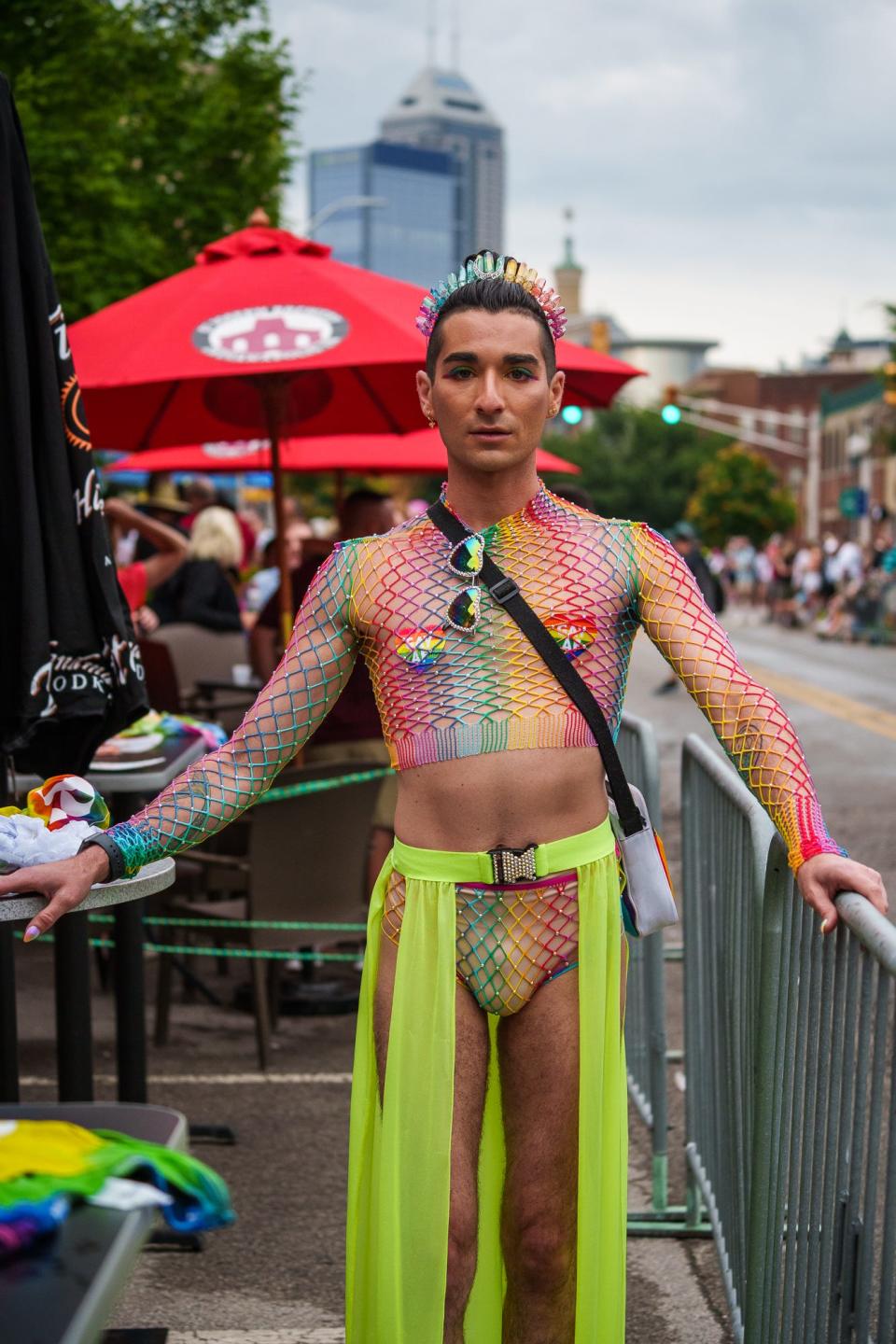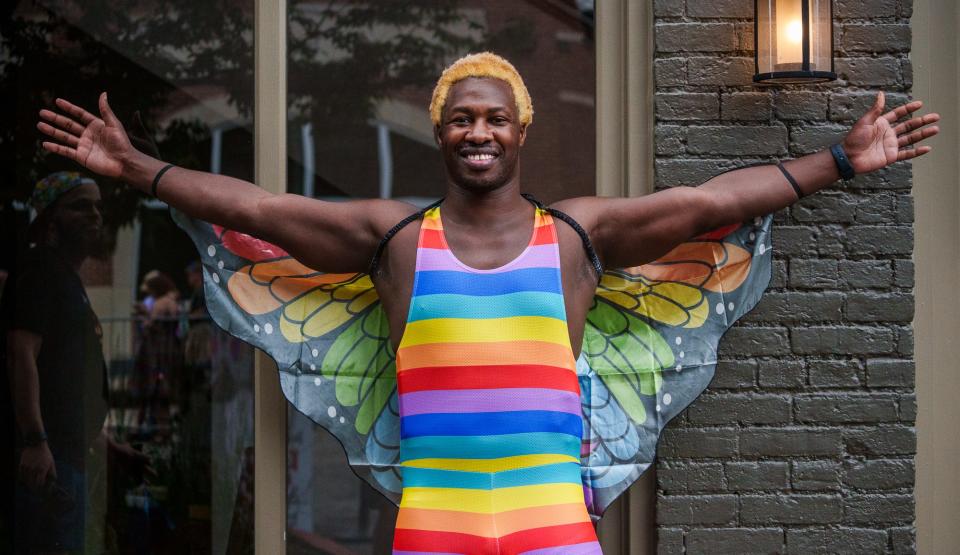Evolution of Pride fashion: From hand-me-downs to glamorous gowns
Clothing has the power to create conversation.
Fashion has played a key role in how people express themselves for centuries, and Pride fashion is no different. Glamour, diversity and comfort in one’s skin are all contributing factors to the evolution queer fashion and expressionism during Pride festivals, whether it be short-shorts and a crop top, a flowy rainbow dress or full drag.
Glamour and opulence such as avant-garde, metallics and flowy clothing — often associated with femininity — are still very much present at Pride festivals, Michael Weston, president of the Indiana Fashion Foundation, said.
Weston said a significant portion of Pride's origins go back to the Stonewall Inn and it having been one of the first gay bars in the late 1960s, which acted as a safe space where people could dress however they wanted.
Strawberries, chicken, beer and tacos: Summer food festivals you need to know about
“Expressionism in general — how we show up, how we’re seen — makes a big difference in how people perceive us,” Weston said. “Starting there, the basis of Pride was being able to express yourself, and fashion and style being so closely related to that. People who dress in drag or dressing androgynously, things like that [are] kind of just part of the conversation about what Pride even is.”
Blair St. Clair, Indianapolis’ own RuPaul’s Drag Race star, said as recently as 20 years ago, Pride was something many people in the city didn’t want to acknowledge. St. Clair, also known as Drew Bryson, said many people dressed boldly and vibrantly — not just to showcase pride in who they are — but also to bring more attention, awareness and acceptance for the LGBTQ+ community.
“At one point in time, it was something about making a spectacle, making a statement, making something not only be heard but be seen,” St. Clair said. “Today, it’s kind of evolved because Pride and queer people have been widely accepted, way more than they ever had 20 years ago.”
A key player in this shift is the fashion industry itself, which Weston said used to be held in high regard in terms of dictating what was fashionable at a given time. However, with the emergence of social media and an increase in body positivity and diversity, this is no longer the case.

“I think what has happened is that people have gotten even that much closer to accurately expressing who they are because the rules are being moved,” Weston said. “I think that's the thing that I love about Pride, that it’s a safe space where you’re just liberated to be exactly who it is that you are, and you’re able to express yourself in the most accurate and most authentic way.”
For many, Pride isn't just a safe place to express oneself, it's also a safe place to explore and try new things, Ben Asaykwee, an Indianapolis-based writer and performer, said in an email to IndyStar.
"Some of us will be dressed in the way we are most comfortable and as we feel truly represents us, and others will be glammed-out just to celebrate freedom and love," they said.
Photos: The inaugural WonderRoad Music Festival kicks off in Indianapolis' Garfield Park
Although the fashion and clothing styles seen at Pride festivals today tend to focus more on being prideful in who one is, St. Clair said she feels much of the fashion is still reminiscent of things worn in years past.
Because another large part of Pride originated in underground spaces, many people still had to hide who they were, St. Clair said. Most people who didn’t present as female didn’t feel comfortable going to the store to buy a dress to then wear in underground nightclubs or Pride Festivals, she said.
“They weren’t using the best of the best makeup products, they weren’t using the craziest of garments,” she said. “They were pulling things together they could just find and buy in the public safely.”
St. Clair described early Pride fashion as a “hodge-podge” of things found in other people’s closets and hand-me-down makeup from mothers, sisters and friends — the brighter, more colorful and sparklier the better.
That much is still true today, only in updated versions as St. Clair said acceptance and access to better makeup and clothing have only increased over the years.
In addition to traditional outfits paying homage to Pride from years past, another thing one might notice each June is the increase in diversity in clothing and fashion at Pride as well as the lack of clothing, Weston said.
“I think that people have just kind of leaned more into an individualistic style,” he said. “I've seen a lot more revealing clothing because I think the more comfortable people have gotten just being who they are and the more society has progressed, I think people have been more comfortable to say ‘hey, you know, this is me, this is how my body is.”
There are still plenty of opportunities for people to step out of the box regarding what would normally be worn in a public setting, Asaykwee said in an email to IndyStar. However, they said many members of the LGBTQ+ community have families of their own now, and most people are respectful of that.

"In the past 10 years, things have definitely gotten a little more family-friendly," they said. "Also, the world has changed, and there are now other chances to express yourselves so the pressure isn't quite as compounded."
Although the climate in Indiana continues to change for LBGTQ communities, acceptance at the local level in Indiana may leave room for hope. One week before IndyPride, St. Clair said she attended Terre Haute’s first-ever Pride on June 4 and was pleasantly surprised at the event’s turnout.
“You see people of all different walks of life that attend Pride,” she said. “It’s not just for queer people by queer people. I think a lot of people assume that Pride is for gay individuals to celebrate themselves, and what it is is we’re celebrating everyone, for allowing us to live our lives and celebrating us for who we are in a safe space.”
One thing guaranteed to be at Pride: rainbows.
"It runs the spectrum for sure, but you will definitely see rainbow-themed color palettes spread far and wide from rainbow speedos to rainbow eye-shadow," Asaykwee said. "It will be a beautifully vibrant and colorful day to truly represent those whom it celebrates."
Contact IndyStar reporter Chloe McGowan at 740-739-1090 or CWilkersonMcGowan@gannett.com. Follow her Twitter: @chloe_mcgowanxx.
This article originally appeared on Indianapolis Star: The origins and evolution of Pride fashion over the years

